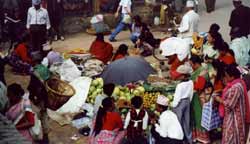MyHimalayasimpressions from |
|
|||||||

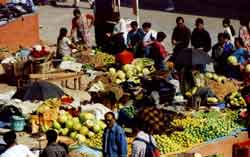
Market scenes in Kathmandu make the city seem more relaxed than it is.
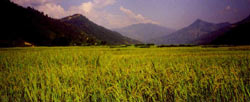
The wide rice fields in the flat valleys and the warm temperates are a great
contrast to the mountain scenery of the coming days.
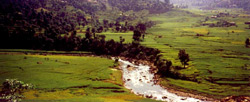
Rice terraces cover the gentle hills north of Gorkha.
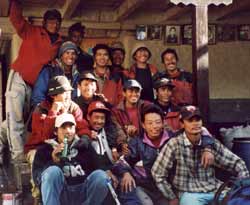
Our crew, Sirdar Bharat at the top left, kitchen crew in foreground, sherpas in
the middle and the toughest porters on the right.
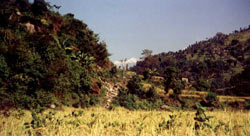
The terraces get steeper as we get further up in the Buri Gandaki gorge.
The high summits of Shringi and Ganesh rise above the yellow fields and lush
hills.
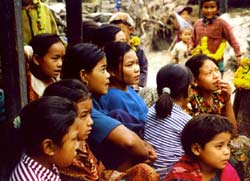
The last day of the important Hindu festival Dawali is celebrated in the small
villages.
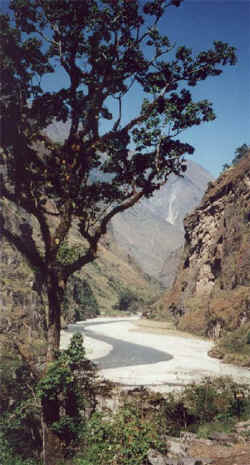
The river runs in a deep gorge most
of the time, the wider spots are a
nice contrast.
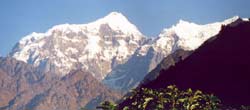
We get closer to the mountains literally day by day, after Jagat the sheer face
of Shringi Himal is the first 'real' mountain we see..
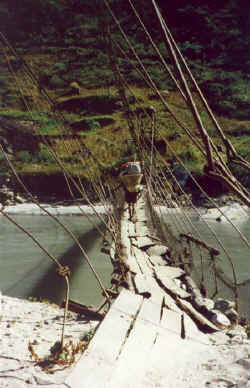
The trails and bridges are in a good condition, considering it was never a much
frequented trade route. Infrastructure has been renewed recently by MCAP
(Manaslu Conservation Area Project).
Manaslu: Kathmandu - Arughat - Lukawa
Kathmandu - Arughat - Lukawa
27.10. Kathmandu - Arughat
A long drive to the starting point of the trek requires an early breakfast. Getting up at 600 will hopefully be easier after two days of trekking. It takes some time to sort the gear out, but then we are ready to "fight" our way out of the city that has become quite busy by now. Driving a large jeep makes it a lot easier since the pedestrians, motorcycles and small taxis simply have to give in because they are smaller. I'm in the car with our guide Jamie and the couple from England that arrived yesterday afternoon. Lizzy and John are from Nottingham and seem really, really nice. I got I touch with Jamie last year because I needed help for my trekking from Dolpo to Kagbeni. Despite the fact that he knew he could not run it he was helping with precious information and found a reliable agency (he probably spent more time for a non-client than other companies do for their own clients). His knowledge and experience is immense, but he does not brag about it. I met him last year, he seemed a great guy to trek with, his small company offers high-quality services at very reasonable prices (see http://www.project-himalaya.com). Tom from Texas (a Nepal-addict like me though his focus seems to be more on scenery than culture), Tracey (a teacher from Canada just starting her three-months-tour around Asia), Dana and Dagmar share the other jeep. A liaison officer will be with us in the restricted area and arrive from Kathmandu tomorrow and catch up with us then. Most of the crew will already be waiting at the campsite.
One popular starting point of the Manaslu Circuit is in Gorkha, an old town that played a dominant role in the Shah dynasty and thus in the history of Nepal. The stunning palace overlooks the village, mountains in the north rise above terraced fields. I am a little disappointed at first that we will set off from Arughat instead - until I hear that this shortcut will give us two more days in the highcountry. Supposedly Maoist activities have spread from the west of Nepal further towards the capital, but apart from the area around Gorkha no incidents were reported so far. Tourists are not targeted, and the few robberies of tourists might not even have been committed by Maoists but just by ordinary criminals. But starting further north will definitely be safer for the crew the liaison officer and us.
Most of the rice in the Kathmandu valley has already been harvested. I expected to spend some time walking through lush rice paddies, but gave up the hope after spotting only brown terraces from the airplane two days earlier. As we drive westwards and get up to a pass leaving the wide, more and more green and yellow fields appear on the hillsides. Despite the haze that hides the mountain ranges, it is a very scenic drive. A well-paved road follows the Trisuli river until we reach a shabby town where we stop for some snacks and tea. There we cross the river and drive towards the mountains. Though there are plans to pave all the roads to the district headquarters, this road will probably be as bumpy in ten years as it is now. But it doesn't really matter to us because in a jeep the drive is very pleasant.
The scenery becomes even more idyllic as we leave the main road. On the flanks of forested hills grows rice in green terraces. Yellow rapeseed and mustard fields, red clay earth, white clouds and blue sky add to the great play of colors. Settlements are spread over the hillsides, its houses are small dots of red and white in lush vegetation. After crossing some foothills and valleys a wide plain appears in front of us. The road descends to the Ankhu Khola and ends there. These 'end-road-villages' can be rather depressing with their air of hopelessness, luckily the people in Karkhetigaon are friendly and not intrusive. We have lunch in a nearby teastall where a woman cooked Dal Baht, the regular Nepali meal of rice and lentils, and some vegetables. After this simple but very tasty lunch we set out for a short walk to the campsite. The porters who were supposed to come with us were hired by a French group yesterday, luckily some local women agree to carry our bags for half a day. Their loads do not look much smaller than the men's, but it does not seem too heavy and they have a good time. Their laughing and chattering does not stop even as it goes steeply uphill after crossing the Ankhu Khola on a small bridge.
The idea of other people carrying your stuff sounds appalling to many Westerners, but in a country with an official unemployment rate of 50% it is a decent job. Provided - of course - that the porters are treated with respect by tourists and guides, that the loads are not too heavy, that the pay is reasonable, that the porters get the necessary equipment higher up, that they are insured against injury or worse. Their wages are ridiculously low (about $3 day and they have to bring their own food), though together with tips it does give people a good source of income. They speak little English, but it is easy to let them know how much you appreciate their work and the assistance of a sherpa doing translating lessens the distance between 'crew' and 'tourist'.
I have not traveled in the lowlands for some years and almost forgot how lovely it is. The subtle changes of colour and contrast (various tones of green on each terrace) are relaxing to eye and mind, especially after three days in crazy Thamel. We climb up through rice fields and forests and reach a plateau where farmland is abundant and fields of grain, millet, rapeseed and mustard cover the area as far as the eye can see. A few cows and waterbuffalos are kept in the villages through which we pass largely unnoticed. The afternoon sun and the smells remind me of the Mediterranean, the absence of steep valleys makes you forget even more than you stand on the foothills of the highest mountains on earth. The clouds that were building up since noon dissolve as we reach the end of the plateau, and two snow-covered summits appear on the horizon. They are probably Shringi Himal and a peak from the Ganesh range. When the sun sets behind the hills, the sky is turning from a light pink to a darker blue, the green rice fields at the bottom of the valley are fading in the dusk. This was a perfect first day!
By the time we get down to the river and cross it on our first suspension bridge, it is dark. We will stay in one of the many guesthouses in Arughat - a nice luxury considering the four weeks of tents and foam mattress ahead of us.
It is the last days of Dawali, a very important Hindu festival; kids are going from house to house performing songs and collecting gifts. Thanks to my cherished earplugs I fall asleep after awhile, but wake up all of a sudden in the middle of the night when something big hits my face. After the first surprise I turn on the flashlight, expecting to find a bat or a lizard on my pillow. Instead it is 'only' a huge grasshopper that is impossible to get out of the room. So I go back to sleep - trying to ignore the splash-splash sound of the locust hitting the wall every few minutes - expecting it to land on my fall on me after every crash. What is waking me up later is not the grasshopper itself, but Tracey's yelling as it lands on her head. Now it really is time to hunt down the insect and after some minutes we throw it out of the window. Relaxing sleep rewards the big hunt.
Arughat - Soti Khola (Day 2)
I am excited about our first real trekking day, and relieved that my knee is not causing any problems. One month ago it was hurting so bad that I could barely walk, and the same pain came back all of a sudden two weeks later. Food is always plentiful and nourishing, especially lunch and dinner. Breakfast is my least favorite meal of the day, relatively speaking: you cannot complain about porridge, toast, eggs, hot chocolate and tea.
We leave the village on a small trail leading to the north. The fog is burning off soon afterwards, revealing bright green and yellow fields across the river. The mist creates a sleepy morning atmosphere, when it starts to dissipate I also start to feel like being wide awake. At first the terraces on our side are not maintained anymore and used as grazing grounds for cows instead. Then it becomes a pleasant walk amidst the yellow fields in warm sunshine, with the wide river below and white summits far ahead. I did not expect to see any mountains for a few days, the snow-capped peaks in the background are a nice preview of the days to come. Huge spiders are hanging in webs that go from one tree to another, cicadas are chirping and the variety of butterflies seems endless. The trail is in much better condition than I expected and this makes fast walking easy. At times we walk high above the river, then right through wide fields further down.
Arughat is the largest village on the trek, from now on we will pass smaller settlements, often consisting of only a few clustered houses . In the lower hills the houses are all built in more variety than in the high country, but still they follow the same principles. They are two stories high with a sloping hay or wooden roof, the walls are white washed and partly painted orange. The orange color is made of cow dung and red clay and applied regularly. Often large banana trees or bamboo surround the house, giving welcome shade on hot days. A small stable for cows or goats can be found a few meters away from the living quarters. And I solve the mystery of the regular 'tump-tump' noises from yesterday night: it came a mill with a foot pedal. It lifts up a cone end that falls on a stone with slightly wider hole and grinds the rice in it. When baked the flour makes for tasty bread.
Gurungs are one of the larger ethnic groups in Nepal. They make a living as farmers and shepherds in the middle hills. Their native language is very different from Nepali and bears scant similarities with Tibetan words, but not enough so I could communicate. Culturally they are influenced by Hindu as well as Buddhist elements. It might be prejudice to blame it on the Hindu influence, but in the villages many men often sit around doing nothing while the women do much of the work at home and in the fields. The older kids take care of their siblings. Most of them are playing in the villages, since it is Saturday and they don't have work at this time of the year.
Two hours after leaving Arughat we cross a wooden bridge and reach Arket, a larger village. I do not like these towns too much; often they have a weird atmosphere because the mixture of tradition and modern times seems very shrill. After a long lunch we walk for another two hours until we reach the camp. The valley has become narrower and the fields are more terraced on the steeper hillsides. Since there is less cultivatable land, the number of houses is decreasing. On a small flat area between river and gorge are a few wooden buildings, the village Soti Khola. I am far ahead and would have walked on if a kid had not stopped me and told me that this is the campsite. I first suspect that he just wants to sell me a Coke, but the soccer game on the nearby field is like a command to stop. It is a lot of fun to play with a dozen of the kids. After running around in hiking boots for an hour my teams leaves the stadium as winners. Hopefully they learned that it is not the team running after the ball that wins, but the team that plays lots of clever passes instead. I give a small donation for a new soccer ball when they ask for it, since this does not fall under 'begging'.
A long time afterwards the porters arrive, just as it got dark. The trail did not strike me as difficult and it was only a few hour of walking. This leaves me wondering how they will manage the longer distances in the coming days.
At home I rarely spend much time outdoors and never camp out. Therefore the first night in the tent is always strange and I do not sleep very well. The warm temperatures make it even more difficult, it is hard not to sweat or to be cold, and the noisy insects are too loud for my earplugs.
Soti Khola - Machu Khola (Day 3)
Beautiful birds' twitter slowly wakes me, but the rooster spoils it all and I am fully awake before sunrise. Half an hour later morning tea is served in the tent, a seemingly colonial ritual but anyone who has been trekking will probably agree that it is too pleasant to abandon it.
Clouds are moving in from the south, making the walking less sweaty than yesterday as we continue to follow the river upstream. I don't mind the clouds at all, in a week we will see all the mountains very close and the fog in the rice terraces creates a nice atmosphere. The steep hills are completely terraced, yet the number of houses is getting smaller and smaller. Most houses are built high on the ridge above the fields that stretch over the entire hillside down to the river. Large waterfalls are numerous on the steep parts of the valley. I have not seen any bridges for the whole morning; the only way to cross the wild Buri Gandaki is a long steel cable with a wooden cart. A group of people is waiting for a seat, it is fun to watch them get into the small cart and get out on the other side. And it does make me appreciate the solid bridges we will encounter during the whole trek.
Usually we walk high above the gray river on decent trails, only some spots are exposed and you can see and hear the river roar a hundred feet almost straight below you. As we get out of the forest, millet fields take over rice paddies, some weeks ago maize was grown and now hangs from the roofs of many houses for drying. It is still Dawali festival and today is the day where flowers are given as presents. It feels really nice to 'get decorated' with flowers as we walk through the villages - often a village is just a group of two or three houses now since the steeper valley does not allow for larger settlements or fields. We stop in Sunigar for lunch where people are really friendly. I suppose that has to do with general good feelings at festivals and also with the fact that the number of (stupid) tourists is relatively small.
Dawali lasts for several days and every day has its own meaning and symbols. On the first four days various animals (starting with crows, then dogs, cows and bullocks) are honored. On the third day people are putting up many candles in their house so the goddess of wealth, Lakshmi, visits them. On the fifth day brothers and sisters meet, put Tikas on each other's forehead and exchange small gifts.
The people of the dozen houses have gathered in the town's center, the men are playing cards while the women are doing their hair (braiding each other's hair and looking for lice), the kids are singing and dancing. It is a really nice place to sit and watch them.
At Labubesi the path splits into a winter and summer trail. Now that monsoon is over, the winter trail along the river is usually the easier option. The riverbed at this spot is almost as wide as the Kali Gandaki and also consists of large white pebbles, but it carries much more sand and sediments. There must have been a sudden rise in the water level, for large parts of the hillside have been washed away. After a short walk on the sandy riverbank the trail climbs up and clings to steep rock faces. The forest is home to many different butterflies and birds, most noticeable are small birds with bright yellow plumage. I am not particularly interested in these animals, but they make for an interesting change when walking for days and days. We have passed many waterfalls since yesterday, now the most spectacular is across the river with water falling down hundreds of feet over two or three steps.
After some more bends we spot a few stone houses near the river. At the first house we meet a group of travelers who look almost as out of place as we tourists do. They are Tibetans from Samdo, easy to recognize from their completely different facial features. Also their clothes and jewelry set them apart from the people we have met so far. After an interesting conversation about conditions near Larkya La they continue their trip to Gorkha.
It is considerably cooler than a day ago, and I'm happy to sit in the warm kitchen and to get to know the members our kitchen crew. During the day they are either behind cleaning up the campsite, or ahead preparing the next meal. Somehow the kitchen guys always seem more careless and less reserved than the Sherpas, a phenomena that is also true here. Since I am not very outgoing either at first, I really like their way of doing things and usually have a great time with all of them after some days. The porters have not arrived yet, so Jamie and the Sherpas go back looking for them. Hopefully nothing happened to them, walking in the dark on the narrow trails is not free of risks. Luckily they are only far behind and too afraid to go on in the dark. Our tents and bags arrive after dinner, and I sleep much better than last night.
Machu Khola - Tatopani (Day 4)
It is a fine day and already quite hot by the time we set off. Most of the porters have arrived by now, three porters with a reputation of being fast carry our bags.
A huge washout at the village's edge has destroyed the school and some other houses two summers ago. There are about 200 glacial lakes in the Himalayas that could break any time, the larger ones are being watched but it is impossible to monitor all of them, let alone take appropriate action. We walk across the wide dried out riverbed of the Machu Khola and cross the small creek on a bridge.
Now that the gorge becomes more narrow and steeper it finally feels like being in the Himalayas and you can really see the powerful collision of the two tectonic plates. For a short while two white summits rise high above us, but soon the valley walls are too steep to see anything from the bottom of it. In small puddles near the river are tadpoles and further up is fresh spawn. Two days further down I noticed a large number of small frogs, maybe the difference in temperature is the reason for the different stages of development, maybe it is just a coincidence. The scenery certainly looks less hospitable now than in the beginning.
Though we did gain quite some altitude at times, we usually lost it the same day because the trail is not level and runs both high above the river and just along its bank. Therefore we are still at 1'000 m, so it is not arid at all but the change of landscape is quite dramatic nevertheless. The large fields have disappeared and given way to cactuses and small trees that cling to the sheer rock faces on both sides of the river. Terraces are not as common as two days ago, and they are much steeper and reaching to the cliff of the vertical gorge. Harvesting must be incredible difficult since no village can be seen anywhere, just getting to the fields requires a long walk. Buckwheat, millet and corn are grown instead of rice; small numbers of goats and cows are driven to the few grazing areas.
The noisy chirping of insects makes the warm temperatures seem even hotter, but in the shade it very pleasant. I expected colder weather in November, but higher up it will probably be freezing. After two hours we reach the campsite in Tatopani ('hot water'), a few houses are built one of the few wider spots in the valley. Ten years ago the hot springs were just running down over rocks, then the Village Development Committee (VDC) 'gave' the springs to a woman whose husband had died. She takes care of the pool and shower. Half of the money goes to the VDC, the other half is hers and I assume that together with the income from the shop she is enjoying a reasonable pension.
The place has nothing to offer except for the springs, but the hot water makes it a perfect place to stay. And the short day gives the porters time to catch up, they are still carrying heavy loads and the trail was certainly more difficult than yesterday. Our sirdar Bharat took the upper trail trying to find more porters in the surrounding villages. I hope he is successful otherwise we will be slowed down - which did not bother me so far, in fact I like easy days at first to get in shape - and we might lose some days.
The pool is not filled with warm water and the small pipe will take forever, so we take showers instead. The water is really hot (in fact hotter than in most of Kathmandu's hotels). I fully enjoy the luxury while having visions about standing in a glacial creek in a few days, and feel like never leaving the shower. But after washing and shaving twice there is no excuse not to go back to camp. At the end of the 4th day I feel as clean as I started.
Tatopani - Yaraphant - Jagat (Day 5)
After a good night's sleep I wake up as usually just before morning tea. Because the festival season is now over, Bharat found more villagers willing to work as porters - and I think he replaced the more lazy ones with others. We pack early so they can leave while we are having breakfast and get to camp at a reasonable time. It takes some days to get into the routine of packing up in the morning, now we are faster and also the loads do not have to be distributed again each day. The porters usually start without a breakfast and walk for two hours in their own pace, taking short breaks every 30 minutes. Around 10 o'clock they cook their own dal baat and continue to the camp where they have dal baat again for dinner.
We usually walk for three hours in the morning, the kitchen crew sometimes passes us and starts preparing lunch when they get to a pleasant spot. On difficult days we have a pack-lunch, but usually they cook a fully-fledged meal. Afterwards they cook dal baht for themselves, I often skip regular lunch and have lots of their delicious lentils and rice with some chilli. After dessert we set off for another two or three hours in the afternoon while the kitchen crew is packing up and following us. At camp we often enjoy hot chocolate and biscuits for a snack, two hours later soup and dinner are ready. It is as luxurious as it sounds. Working as a kitchen boy is probably the hardest job on the trek, you have to get up early to prepare breakfast, then hurry to get lunch ready, then walk fast to the camp site to fix dinner - and fetching water and cleaning dishes and carrying a large basket full of the kitchen equipment and serving tourists and being nice and friendly.
Their wages are not much higher than a porters', but they get free food and the experience increases chances of becoming cook or sherpa.
Another day, another scenery: farm and moss grow on the trees, the forest gets denser and the ground is wet and muddy. From a bridge across the wild Buri Gandaki we watch a group of brown monkeys. Entire families sit on the nearby trees; sometimes they jump from high up to another tree and grab some branches that swing down precariously close to the ground from all the weight, and then swing up again. Near the riverbank is another monkey that looks totally different; its black face long white hair on the rest of the head makes Langurs look like they're wearing helmets.
We slowly climb up from the river while the valley is still in shade. One hour later a steep rock face just ahead is brightly lit by the morning sun which turns out all the different tones of red, green and yellow on the steep rock face. The thick forest only covers the valley floor, terraces cover the rest of the hill. A village is lying at the foot of the hill, the blue smoke coming from the roofs gives it a sleepy atmosphere. Just before entering Dobat a ghost trap lies on the trail. Though it is not a purely Buddhist custom, one often finds it in areas where Tibetan Buddhism is practiced and mixed with old local tradition.
After crossing a creek on a long suspension bridge the main valley becomes even narrower. The trail goes up and down constantly but stones plates make for easy walking and useful exercise. From a grassy plateau it is only a few more minutes to Yaraphant, a cluster of three houses above the broad riverbed. The basin looks fascinating from high up. The wide valley cannot be used for agriculture, because most of it has been washed away and is covered by gray pebbles. The sidevalley towards Ganesh Himal would be worth exploring, but we do not have the time.
I saw locals taking the winter trail along the riverbank, therefore I am also heading there after lunch. The Yara Khola proves too wide to jump across, so I walk to the suspension bridge whose foundation is solid but many planks are broken or missing completely. The uncomfortable feeling when crossing it is rewarded by great views from the upper trail towards the south. High cliffs rise on the left and right, the river flows through a narrow fissure in a ridge straight ahead. Half an hour further up we cross a bridge where the water roars through a narrow canyon, then the river widens again. Walking never gets dull in such a landscape!
Shortly before Jagat the trail resembles a freeway, it is six feet wide and neatly covered with stone plates. The village is so clean that it feels almost out of place. Solid stone houses are built close to each other, its front walls nicely painted. Though we have still some days to go before reaching the Tibetan communities, the people here are also Buddhist and a large chorten with carved prayers stands at the end of the village. We relax in a nice garden at the town's entrance and put up the tents. This was certainly not a very long day either, but since the porters arrive almost at the same time as we do, we might be able to walk longer days from now on.
The Manaslu Conservation Area starts here, and the village seems to be the last outpost of the Kathmandu administration. Half a dozen men from the low land are working in the post office, police checkpost and the school. Bypassing the police post is almost impossible because of the steep cliffs, and every year a few Tibetan refugees die on their way to Kathmandu when they attempt to sneak around checkposts. Allegedly the Chinese border guards pay good money to the Nepali policemen for every refugee that is handed back to them (especially these days after the flight of several prominent religious figures). I met a Western scholar who declared the two refugees he had met in Tsum as 'assistants' and brought them safely down to Gorkha. Some of them try to stay in Boudnath, but most are continuing to Dharamsala, the seat of the exile government, to see His Holiness the Dalai Lama.
Jagat - Eklabhatti - Lukawa (Day 6)
A howling dog wakes me up in the middle of the night; it sounds as if it is about to come into my tent. Luckily it is not as persistent as dogs in Kathmandu and I can go back to sleep after ten minutes. We have decided to use some of our days reserved for exploring for going up the Tsum valley. I did not realize the valley was so easy to reach from the Manaslu Circuit, and the sudden opportunity to follow Snellgrove's footsteps is a nice surprise. We probably won't be able to go as far north as I would like, but at least I will get a glimpse of the valley. Only a few porters will go with us on the sidetrip, the regular loads will be brought to Nupri. We sort our stuff out in the morning to make the loads lighter. After three days we will meet with them further up on the Circuit, and hopefully I'll have access to all my chocolate again.
Some of the porters take a shortcut and wade through a little creek after Jagat; the regular trail with a suspension bridge takes a few minutes longer but is rewarded by passing just next to two impressive waterfalls with wide pools below. After the next bend in the river a small white stripe of snow appears behind a high ridge. Since yesterday more and more mountains are revealed; now we get a full view of a large vertical rock wall and a steep icefall to the right, almost like a smaller version of Nilgiri or the Eiger north face. This is Shringi Himal, 7'187 meters high and the tallest peak north of the Buri Gandaki.
The ridge just in front of us hides the rest of the range, but the views are a welcome reminder that 'we are getting there'. With 'there' I do not necessarily mean the mountains but the highcountry in general with all the things it offers - great mountains, pleasant plains, different culture and people. We walk through some neat villages that seem only inhabited by small children. The women are cutting grass on steep slopes outside the villages, harvesting seems over and most of the things now growing do not need to be looked after (i.e. beans growing on dead maize stalks). The men are either away on trade or on the pastures with the animals.
First mani wall, first tourists passing it on the wrong side...
Where the river widens we cross it on a long a shaky bridge and climb steeply up to Philin. It is a little relief to see that others are sweating even more in the hot sun: a dozen Tibetans from Sama in their thick woolen chubas are travelling down to Gorkha. Baby production in the village is high even for Nepali standards, at every second house a child is rubbed with ointment, or fed or just left alone screaming. MCAP (Manaslu Conservation Area Project) has a small visitor center and checkpost. Their goal is to combine the development of the villages with the protection of resources and the promotion of tourism. These goals are not as diametrically opposed as they seem at first glance. The first project of that kind in the Annapurna region (ACAP) is successful and accepted by local people. Other areas in Nepal were declared National Parks, but I do not know enough to compare the two models.
The views from high above the river are fine and I enjoy the 'Mediterranean' walk; lizards scamper across the trail, cactuses and other plants create a pleasant smell of dry grass and herbs. Across the valley lies Pangsing, a large village built on the steep hillside. Eklabhatti is not an especially nice spot and offers no shade against the hot sun, so I leave soon after enjoying lunch. This is the most exciting part of the trail so far, it runs on a ledge opposite a sheer rock face and then disappears in the narrow valley. The shade is a welcome change after a whole morning in the sun. A long waterfall is coming down on our side, turns into a creek where we cross it and becomes a waterfall again a few meters below the trail. The wider path goes down to the river and to Nyak or Deng. We take the smaller one climbing up instead. The gorge is very rugged, but at some spots it is completely overgrown by green grass and light green conifers, which creates a strange contrast and very peaceful atmosphere.
I almost step on a Preying Mantis, a fascinating insect with its strange looking bright green body parts. Soon afterwards I see my first snake after 5 trekkings in the Himalayas, a two-feet long thin gray reptile, getting it into a photogenic position with the help of a stick takes some time. When I get closer to what I thought to be two birds fighting over food, the birds turn out to be two huge black butterflies.
We climb higher and higher on an 'exposed' trail (I wonder who came up with such a nice sounding word for describing dangerous trails) and reach a remarkable spot where the Shar Khola (Eastern river) flows in the Buri Gandaki, offering views into both valleys: Nupri to the west with a high peak at its end and the Tsum valley to the east with a huge white summit above the ridge. Unfortunately it is hidden in white clouds two minutes later.
Our camp will be at Lukuwa but despite our fast walking we have not come through a village and I am afraid to have missed it when I meet a man with Tibetan features in front of his house. He does not speak any Tibetan, and his Nepali is a bit strange but after Tom's third attempt we find out that we are in fact in Lukuwa. Snellgrove described the village as 'typically Tibetan', I wonder what happened to the settlement in these fifty years. A small plateau two minutes ahead will be just large enough for all our tents.
Two girls and her mother are working in the fields above the two houses. Millet was cut last week, now the rest is ripped out, the earth shaken off the roots and then the dry grass is added to a pile. Much to the amusement to the two girls I help them for half an hour. I am doing a decent job but soon my back starts to hurt and I give up - it also gets rather cold as the sun is about to set. After good dinner I go to bed, or thermarest, early at 700.
The long hours of sleeping are what makes trekking holiday-ish even in the eyes of non-trekkers.
|
Summary Part 1:
After busy (some call it crazy) Kathmandu the half-day drive through Nepal's lovely countryside to the starting point of our trek is a relaxing and very promising beginning. Rice terraces and yellow rapeseed fields cover the hillsides and wide valleys. We enjoy the warm sunshine and the blue sky, haze hides the mountain ranges in the north. From Arughat we follow the Buri Gandaki upstream along lush rice fields and pass through small Gurung villages where people are celebrating the Daiwali festival. The gorge narrows and makes agriculture increasingly difficult, dense forests now grow along the river instead of cultivated fields. The trail is constantly going up and down now, but the altitude gain is moderate. Instead of following the standard route to Nupri, we take the narrow exposed trail that goes to Tsum. The valley stretches far into Tibetan terrirtory and offers stunning views of Shringi Himal and the Ganesh range. |
